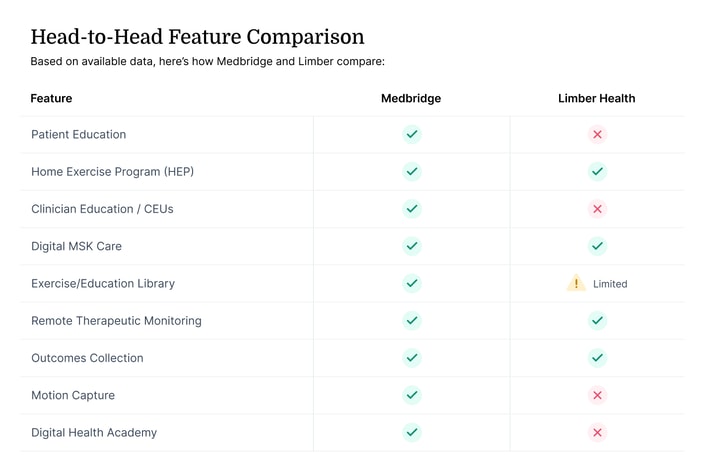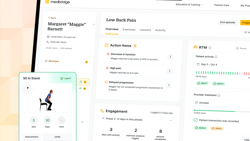Medbridge vs Limber Health: Choosing the Right Digital Care Software
This article provides a detailed comparison of Medbridge vs Limber Health. By examining the breadth of home exercise content, patient education resources, and patient engagement, decision-makers can better understand which platform aligns with their goals.
September 12, 2025
7 min. read

Healthcare organizations today face increasing pressure to deliver high-quality care while maintaining efficiency, patient engagement, and financial stability. As digital care software becomes more integral to physical therapy and rehabilitation, providers are comparing platforms that offer Remote Therapeutic Monitoring (RTM), Home Exercise Programs (HEP), Patient Reported Outcomes (PROs), and patient engagement tools. Two common options are Medbridge and Limber Health, each offering different approaches to supporting providers and patients.
This article provides a detailed comparison of Medbridge vs Limber Health. By examining the breadth of home exercise content, patient education resources, and patient engagement, decision-makers can better understand which platform aligns with their goals.
Clinical & Patient Engagement Tools
For healthcare organizations looking for digital care software to enhance patient engagement, three factors are key to supporting outcomes and streamlining care delivery:
Access to a robust home exercise program library
Valuable data provided by patient-reported outcomes
Patient engagement and revenue opportunities offered by remote therapeutic monitoring
Medbridge
Home Exercise Programs:
Medbridge’s Home Exercise Programs feature the highest quality evidence-based videos and educational resources on the market, with customizable exercise templates to support in-person therapy. With over 8,000 exercises spanning physical therapy, occupational therapy, speech-language pathology, and athletic training, providers can create programs for every setting and specialty or upload their own custom exercises.
Patient Reported Outcomes (PROs):
Medbridge PROs give organizations a comprehensive view of patient progress between appointments, helping providers gain deeper insights into outcomes. Providers can view Patient Reported Outcomes, like PROMIS-CAT for individual patients, with AI summaries providing a quick rundown of patient activity. Movement assessments using motion capture provide a complete picture of patient progress. Organizations can also view PROs at the organizational level, so they can see trends and impact to negotiate with payers and share with referral partners.
Remote Therapeutic Monitoring:
Unlike other RTM solutions, Medbridge bakes remote care directly into the patient’s care plan—not as an add-on, but as an integrated workflow. Medbridge’s Remote Therapeutic Monitoring Solution allows organizations to digitally assign programs, monitor patient progress, communicate with patients, and accurately track for efficient RTM billing. Providers who are already stretched thin for time can track patient activity and clock provider activity without extra work, and an automatic timer runs as providers monitor patients, so they never have to worry about forgetting to log billing time. It also helps organizations capture additional revenue, with everything clinicians need to assign programs, remotely monitor and communicate with patients, and track and report—all in a single location.
Clinician Education
Medbridge’s Educate solution gives clinicians access to over 3,000 high-quality courses and educational resources on a single platform, elevating their skills and addressing everyday challenges so they are better prepared to deliver the highest quality patient care every single day. Every program is curated by top industry experts, from leading clinical instructors to Medbridge’s Medical Advisory Board, and delivered on an intuitive digital platform.
Limber Health
While Limber provides RTM and HEP with a smaller library of education and exercise resources, it does not include motion capture, and its patient experience is limited to a native app. While this works for organizations seeking a basic toolset, the narrower focus means practices may need to layer on additional solutions to cover gaps.
Why it matters
Healthcare organizations benefit from a one-stop platform like Medbridge that offers the breadth of tools needed to engage patients and support providers without fragmenting workflows.
Care Model: Provider-Driven vs Service-Driven
The care model underlying each platform shapes how practices maintain patient relationships and continuity of care.
Medbridge
Medbridge is built on a provider-driven model, so patients remain within the practice’s system, preserving continuity and strengthening trust between patient and clinician. This ensures providers maintain visibility and control over engagement, adherence, and outcomes.
Limber Health
Many customers use Limber for their service-based model, which offers case management, meaning that Limber staff may manage patients outside of the provider’s system. While this can reduce administrative burden, it also creates a disjointed patient experience, potentially weakening the provider-patient relationship and diminishing practice visibility.
Why it matters
Healthcare provider organizations thrive when patients remain closely connected to their clinicians. Medbridge keeps patients within the health system, supporting consistent communication and brand loyalty.
Innovation and Platform Roadmap
Between growing patient demand for digital care options and CMS’ proposed expansion of remote therapeutic monitoring CPT codes, digital care platforms must continuously innovate to meet new clinical, regulatory, and patient expectations.
Medbridge
Medbridge is actively investing in new technology, including automation, AI-driven engagement, and digital care pathways. Medbridge recently acquired Rehab Boost, a pioneering motion capture and movement-based artificial intelligence (AI) company, and relaunched the technology as Medbridge Motion Capture, providing Medbridge with in-house motion capture and AI capabilities. Medbridge also recently launched its One Care platform, combining HEP, PROs, RTM, and Guided Care Pathways into a single, connected platform.
Its EMR-agnostic approach means that the Medbridge platform integrates with multiple systems like Epic, Cerner, Raintree, and Casamba, offering stability and flexibility regardless of which EMR a practice uses. Medbridge’s roadmap is shaped by provider needs and broad applicability across rehabilitation care.
Limber Health
Limber was recently acquired by Net Health EMR. The acquisition leverages complementary strengths that support clinicians and patients from “hospital to home,” with the stated goal of more effective hybrid care models and value-based outcomes.
Why it matters
For practices that value independence and long-term stability, Medbridge offers a future-ready, EMR-agnostic solution, while Limber may feel restrictive for non-Net Health customers.
Pricing Models and Financial Considerations
Financial predictability is a core concern for healthcare organizations balancing revenue and costs.
Medbridge
Medbridge operates on a transparent subscription model, giving practices predictable costs for access to its digital care ecosystem. This model offers both price-per-seat/year and price-per-episode models and also includes tools, training, and support, making it easier for practices to budget and plan.
Limber Health
Pricing is not publicly listed.
Why it matters
Practices seeking control over their revenue streams may prefer Medbridge’s transparent, clear and consistent subscription model over Limber’s unknown pricing structure.
Support and Practice Success
Support services play a vital role in maximizing platform value and ensuring long-term success.
Medbridge
Medbridge provides robust support through training, onboarding, and practice success resources. The client success team partners with organizations to implement solutions, optimize workflows, and achieve measurable outcomes.
Medbridge’s Digital Health Academy provides both front-line clinicians and organizational leaders with the necessary tools to develop the knowledge and skills essential to digital care success.
Medbridge’s Help Center provides the latest announcements, FAQs, instructional training videos, account information, and product updates, allowing organizations and clinicians an easy way to stay updated and get answers to common questions.
Limber Health
On top of standard onboarding and support, Limber appeals to organizations seeking outsourced support for RTM (such as handling calls, reminders, or monitoring). While this reduces staff workload, it shifts responsibility away from providers and can disconnect patients from their primary clinical team.
Why it matters
Practices that prioritize keeping patient care and engagement under their own brand may find Medbridge’s direct provider support more aligned with their goals.
How Medbridge VS. Limber Stack Up

Making the Right Choice
When comparing Medbridge vs Limber Health, the choice comes down to control, comprehensiveness, and long-term sustainability. Medbridge’s provider-driven model, broader clinical ecosystem, transparent pricing, and commitment to innovation make it the stronger fit for practices that want to:
Keep patients connected within their system
Access a wide range of tools from HEP to telehealth
Maintain financial predictability
Adopt a future-ready, EMR-agnostic platform
Limber Health offers solutions for providers, payors, and employers. While Limber Health may appeal to practices seeking outsourced case management or flexible pricing models, it comes with trade-offs in patient continuity, revenue predictability, and innovation independence.
Bottom line: For organizations focused on patient relationships, practice growth, and comprehensive digital care, Medbridge Care provides a more sustainable and provider-centric solution than Limber Health.





